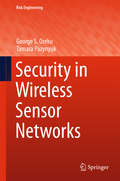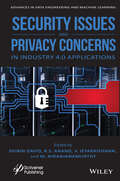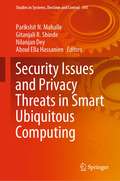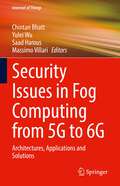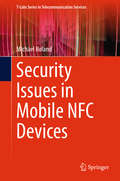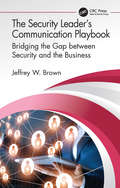- Table View
- List View
Security in Vehicular Networks: Focus on Location and Identity Privacy
by Leila Benarous Salim Batim Abdelhamid MelloukSecurity in Vehicular Networks: Focus on Location and Identity Privacy
by Abdelhamid Mellouk Leila Benarous Salim BatimVehicular networks were first developed to ensure safe driving and to extend the Internet to the road. However, we can now see that the ability of vehicles to engage in cyber-activity may result in tracking and privacy violations through the interception of messages, which are frequently exchanged on road. This book serves as a guide for students, developers and researchers who are interested in vehicular networks and the associated security and privacy issues. It facilitates the understanding of the technologies used and their various types, highlighting the importance of privacy and security issues and the direct impact they have on the safety of their users. It also explains various solutions and proposals to protect location and identity privacy, including two anonymous authentication methods that preserve identity privacy and a total of five schemes that preserve location privacy in the vehicular ad hoc networks and the cloud-enabled internet of vehicles, respectively. This book also presents a new privacy-aware blockchain-based pseudonym management framework.Vehicular networks were first developed to ensure safe driving and to extend the Internet to the road. However, we can now see that the ability of vehicles to engage in cyber-activity may result in tracking and privacy violations through the interception of messages, which are frequently exchanged on road. This book serves as a guide for students, developers and researchers who are interested in vehicular networks and the associated security and privacy issues. It facilitates the understanding of the technologies used and their various types, highlighting the importance of privacy and security issues and the direct impact they have on the safety of their users. It also explains various solutions and proposals to protect location and identity privacy, including two anonymous authentication methods that preserve identity privacy and a total of five schemes that preserve location privacy in the vehicular ad hoc networks and the cloud-enabled internet of vehicles, respectively. This book also presents a new privacy-aware blockchain-based pseudonym management framework. Leila
Security in Wireless Mesh Networks
by Yan Zhang Jun Zheng Honglin HuWireless mesh networks (WMN) encompass a new area of technology set to play an important role in the next generation wireless mobile networks. WMN is characterized by dynamic self-organization, self-configuration, and self-healing to enable flexible integration, quick deployment, easy maintenance, low costs, high scalability, and reliable services.
Security in Wireless Mesh Networks
by Yan Zhang Jun Zheng Honglin HuWireless mesh networks (WMN) encompass a new area of technology set to play an important role in the next generation wireless mobile networks. WMN is characterized by dynamic self-organization, self-configuration, and self-healing to enable flexible integration, quick deployment, easy maintenance, low costs, high scalability, and reliable services.
Security in Wireless Sensor Networks (Risk Engineering)
by George S. Oreku Tamara PazynyukThis monograph covers different aspects of sensor network security including new emerging technologies. The authors present a mathematical approach to the topic and give numerous practical examples as well as case studies to illustrate the theory. The target audience primarily comprises experts and practitioners in the field of sensor network security, but the book may also be beneficial for researchers in academia as well as for graduate students.
Security Informatics: Second Symposium On Intelligence And Security Informatics, Isi 2004, Tucson, Az, Usa, June 10-11, 2004, Proceedings (Annals of Information Systems #9)
by Christopher C. Yang Michael Chau Jau-Hwang Wang Hsinchun ChenIntelligence and Security Informatics (ISI) is defined as the study of the development and use of advanced information systems and technologies for national, international, and societal security-related applications. With the rise of global terrorism, the field has been given an increasing amount of attention from academic researchers, law enforcement, intelligent experts, information technology consultants and practitioners. SECURITY INFORMATICS is global in scope and perspective. Leading experts will be invited as contributing authors from the US, UK, Denmark, Israel, Singapore, Hong Kong, Taiwan, Europe, etc. It is the first systematic, archival volume treatment of the field and will cover the very latest advances in ISI research and practice. It is organized in four major subject areas: (1) Information and Systems Security, (2) Information Sharing and Analysis in Security Informatics, (3) Infrastructure Protection and Emergency Responses, and (4) National Security and Terrorism Informatics.
Security Infrastructure Technology for Integrated Utilization of Big Data: Applied to the Living Safety and Medical Fields
by Atsuko Miyaji Tomoaki MimotoThis open access book describes the technologies needed to construct a secure big data infrastructure that connects data owners, analytical institutions, and user institutions in a circle of trust. It begins by discussing the most relevant technical issues involved in creating safe and privacy-preserving big data distribution platforms, and especially focuses on cryptographic primitives and privacy-preserving techniques, which are essential prerequisites. The book also covers elliptic curve cryptosystems, which offer compact public key cryptosystems; and LWE-based cryptosystems, which are a type of post-quantum cryptosystem. Since big data distribution platforms require appropriate data handling, the book also describes a privacy-preserving data integration protocol and privacy-preserving classification protocol for secure computation. Furthermore, it introduces an anonymization technique and privacy risk evaluation technique.This book also describes the latest related findings in both the living safety and medical fields. In the living safety field, to prevent injuries occurring in everyday life, it is necessary to analyze injury data, find problems, and implement suitable measures. But most cases don’t include enough information for injury prevention because the necessary data is spread across multiple organizations, and data integration is difficult from a security standpoint. This book introduces a system for solving this problem by applying a method for integrating distributed data securely and introduces applications concerning childhood injury at home and school injury. In the medical field, privacy protection and patient consent management are crucial for all research. The book describes a medical test bed for the secure collection and analysis of electronic medical records distributed among various medical institutions. The system promotes big-data analysis of medical data with a cloud infrastructure and includes various security measures developed in our project to avoid privacy violations.
Security Intelligence: A Practitioner's Guide to Solving Enterprise Security Challenges
by Qing Li Gregory ClarkSimilar to unraveling a math word problem, Security Intelligence: A Practitioner's Guide to Solving Enterprise Security Challenges guides you through a deciphering process that translates each security goal into a set of security variables, substitutes each variable with a specific security technology domain, formulates the equation that is the deployment strategy, then verifies the solution against the original problem by analyzing security incidents and mining hidden breaches, ultimately refines the security formula iteratively in a perpetual cycle. You will learn about: Secure proxies – the necessary extension of the endpoints Application identification and control – visualize the threats Malnets – where is the source of infection and who are the pathogens Identify the security breach – who was the victim and what was the lure Security in Mobile computing – SNAFU With this book, you will be able to: Identify the relevant solutions to secure the infrastructure Construct policies that provide flexibility to the users so to ensure productivity Deploy effective defenses against the ever evolving web threats Implement solutions that are compliant to relevant rules and regulations Offer insight to developers who are building new security solutions and products
Security Intelligence: A Practitioner's Guide to Solving Enterprise Security Challenges
by Qing Li Gregory ClarkSimilar to unraveling a math word problem, Security Intelligence: A Practitioner's Guide to Solving Enterprise Security Challenges guides you through a deciphering process that translates each security goal into a set of security variables, substitutes each variable with a specific security technology domain, formulates the equation that is the deployment strategy, then verifies the solution against the original problem by analyzing security incidents and mining hidden breaches, ultimately refines the security formula iteratively in a perpetual cycle. You will learn about: Secure proxies – the necessary extension of the endpoints Application identification and control – visualize the threats Malnets – where is the source of infection and who are the pathogens Identify the security breach – who was the victim and what was the lure Security in Mobile computing – SNAFU With this book, you will be able to: Identify the relevant solutions to secure the infrastructure Construct policies that provide flexibility to the users so to ensure productivity Deploy effective defenses against the ever evolving web threats Implement solutions that are compliant to relevant rules and regulations Offer insight to developers who are building new security solutions and products
Security Issues and Privacy Concerns in Industry 4.0 Applications
by Shibin David R. S. Anand V. Jeyakrishnan M. NiranjanamurthyThe scope of Security Issues, Privacy Concerns in Industry 4.0 Applications is to envision the need for security in Industry 4.0 applications and the research opportunities for the future. This book discusses the security issues in the Industry 4.0 applications for research development. It will also enable the reader to develop solutions for the security threats and attacks that prevail in the industry. The chapters will be framed on par with advancements in the industry in the area of Industry 4.0 with its applications in additive manufacturing, cloud computing, IoT (Internet of Things), and many others. This book helps a researcher and an industrial specialist to reflect on the latest trend and the need for technological change in Industry 4.0. Smart water management using IoT, cloud security issues with network forensics, regional language recognition for industry 4.0, IoT based health care management system, artificial intelligence for fake profile detection, and packet drop detection in agriculture-based IoT are covered in this outstanding new volume. Leading innovations such as smart drone for railway track cleaning, everyday life-supporting blockchain and big data, effective prediction using machine learning, classification of the dog breed based on CNN, load balancing using the SPE approach and cyber culture impact on media consumers are also addressed. Whether a reference for the veteran engineer or an introduction to the technologies covered in the book for the student, this is a must-have for any library.
Security Issues and Privacy Concerns in Industry 4.0 Applications
by Shiblin David R. S. Anand V. Jeyakrishnan M. NiranjanamurthyThe scope of Security Issues, Privacy Concerns in Industry 4.0 Applications is to envision the need for security in Industry 4.0 applications and the research opportunities for the future. This book discusses the security issues in the Industry 4.0 applications for research development. It will also enable the reader to develop solutions for the security threats and attacks that prevail in the industry. The chapters will be framed on par with advancements in the industry in the area of Industry 4.0 with its applications in additive manufacturing, cloud computing, IoT (Internet of Things), and many others. This book helps a researcher and an industrial specialist to reflect on the latest trend and the need for technological change in Industry 4.0. Smart water management using IoT, cloud security issues with network forensics, regional language recognition for industry 4.0, IoT based health care management system, artificial intelligence for fake profile detection, and packet drop detection in agriculture-based IoT are covered in this outstanding new volume. Leading innovations such as smart drone for railway track cleaning, everyday life-supporting blockchain and big data, effective prediction using machine learning, classification of the dog breed based on CNN, load balancing using the SPE approach and cyber culture impact on media consumers are also addressed. Whether a reference for the veteran engineer or an introduction to the technologies covered in the book for the student, this is a must-have for any library.
Security Issues and Privacy Threats in Smart Ubiquitous Computing (Studies in Systems, Decision and Control #341)
by Aboul Ella Hassanien Nilanjan Dey Parikshit N. Mahalle Gitanjali R. ShindeThis book extends the work from introduction of ubiquitous computing, to the Internet of things to security and to privacy aspects of ubiquitous computing. The uniqueness of this book is the combination of important fields like the Internet of things and ubiquitous computing. It assumes that the readers’ goal is to achieve a complete understanding of IoT, smart computing, security issues, challenges and possible solutions. It is not oriented towards any specific use cases and security issues; privacy threats in ubiquitous computing problems are discussed across various domains. This book is motivating to address privacy threats in new inventions for a wide range of stakeholders like layman to educated users, villages to metros and national to global levels. This book contains numerous examples, case studies, technical descriptions, scenarios, procedures, algorithms and protocols. The main endeavour of this book is threat analysis and activity modelling of attacks in order to give an actual view of the ubiquitous computing applications. The unique approach will help readers for a better understanding.
Security Issues for Wireless Sensor Networks
by Parag Verma Ankur Dumka Anuj Bhardwaj Navneet Kaur Alaknanda Ashok Anil Kumar Bisht Raksh Pal GangwarWireless sensor networks (WSNs) have attracted high interest over the last few decades in the wireless and mobile computing research community. Applications of WSNs are numerous and growing, including indoor deployment scenarios in the home and office to outdoor deployment in an adversary’s territory in a tactical background. However, due to their distributed nature and deployment in remote areas, these networks are vulnerable to numerous security threats that can adversely affect their performance. This problem is more critical if the network is deployed for some mission-critical applications, such as in a tactical battlefield. Random failure of nodes is also very likely in real-life deployment scenarios. Due to resource constraints in the sensor nodes, a traditional security mechanism with high overhead of computation and communication is not feasible in WSNs. Design and implementation of secure WSNs is, therefore, a particularly challenging task. This book covers a comprehensive discussion on state-of-the-art security technologies for WSNs. It identifies various possible attacks at different layers of the communication protocol stack in a typical WSN and presents their possible countermeasures. A brief discussion on the future direction of research in WSN security is also included.
Security Issues for Wireless Sensor Networks
by Parag Verma Ankur Dumka Anuj Bhardwaj Navneet Kaur Alaknanda Ashok Anil Kumar Bisht Raksh Pal GangwarWireless sensor networks (WSNs) have attracted high interest over the last few decades in the wireless and mobile computing research community. Applications of WSNs are numerous and growing, including indoor deployment scenarios in the home and office to outdoor deployment in an adversary’s territory in a tactical background. However, due to their distributed nature and deployment in remote areas, these networks are vulnerable to numerous security threats that can adversely affect their performance. This problem is more critical if the network is deployed for some mission-critical applications, such as in a tactical battlefield. Random failure of nodes is also very likely in real-life deployment scenarios. Due to resource constraints in the sensor nodes, a traditional security mechanism with high overhead of computation and communication is not feasible in WSNs. Design and implementation of secure WSNs is, therefore, a particularly challenging task. This book covers a comprehensive discussion on state-of-the-art security technologies for WSNs. It identifies various possible attacks at different layers of the communication protocol stack in a typical WSN and presents their possible countermeasures. A brief discussion on the future direction of research in WSN security is also included.
Security Issues in Fog Computing from 5G to 6G: Architectures, Applications and Solutions (Internet of Things)
by Chintan Bhatt Yulei Wu Saad Harous Massimo VillariThe book provides an examination of how fog security is changing the information technology industry and will continue to in the next decade. The authors first discuss how fog enables key applications in wireless 5G, the Internet of Things, and big data. The book then presents an overview of fog/edge computing, focusing on its relationship with cloud technology, Internet of Things and the future with the use of secure 5G/6G communication. The book also presents a comprehensive overview of liabilities in fog/edge computing within multi-level architectures and the intelligent management. The last part of the book reviews applications of fog/edge computing in smart cities, including in Industrial IoT, edge-based augmented reality, data streaming, and blockchain-based.
Security Issues in Mobile NFC Devices (T-Labs Series in Telecommunication Services)
by Michael RolandThis work provides an assessment of the current state of near field communication (NFC) security, it reports on new attack scenarios, and offers concepts and solutions to overcome any unresolved issues. The work describes application-specific security aspects of NFC based on exemplary use-case scenarios and uses these to focus on the interaction with NFC tags and on card emulation. The current security architectures of NFC-enabled cellular phones are evaluated with regard to the identified security aspects.
The Security Leader’s Communication Playbook: Bridging the Gap between Security and the Business (Internal Audit And It Audit Ser.)
by Jeffrey W. BrownThis book is for cybersecurity leaders across all industries and organizations. It is intended to bridge the gap between the data center and the board room. This book examines the multitude of communication challenges that CISOs are faced with every day and provides practical tools to identify your audience, tailor your message and master the art of communicating. Poor communication is one of the top reasons that CISOs fail in their roles. By taking the step to work on your communication and soft skills (the two go hand-in-hand), you will hopefully never join their ranks. This is not a “communication theory” book. It provides just enough practical skills and techniques for security leaders to get the job done. Learn fundamental communication skills and how to apply them to day-to-day challenges like communicating with your peers, your team, business leaders and the board of directors. Learn how to produce meaningful metrics and communicate before, during and after an incident. Regardless of your role in Tech, you will find something of value somewhere along the way in this book.
The Security Leader’s Communication Playbook: Bridging the Gap between Security and the Business (Internal Audit And It Audit Ser.)
by Jeffrey W. BrownThis book is for cybersecurity leaders across all industries and organizations. It is intended to bridge the gap between the data center and the board room. This book examines the multitude of communication challenges that CISOs are faced with every day and provides practical tools to identify your audience, tailor your message and master the art of communicating. Poor communication is one of the top reasons that CISOs fail in their roles. By taking the step to work on your communication and soft skills (the two go hand-in-hand), you will hopefully never join their ranks. This is not a “communication theory” book. It provides just enough practical skills and techniques for security leaders to get the job done. Learn fundamental communication skills and how to apply them to day-to-day challenges like communicating with your peers, your team, business leaders and the board of directors. Learn how to produce meaningful metrics and communicate before, during and after an incident. Regardless of your role in Tech, you will find something of value somewhere along the way in this book.
Security Log Management: Identifying Patterns in the Chaos
by Jacob BabbinThis book teaches IT professionals how to analyze, manage, and automate their security log files to generate useful, repeatable information that can be use to make their networks more efficient and secure using primarily open source tools. The book begins by discussing the “Top 10" security logs that every IT professional should be regularly analyzing. These 10 logs cover everything from the top workstations sending/receiving data through a firewall to the top targets of IDS alerts. The book then goes on to discuss the relevancy of all of this information. Next, the book describes how to script open source reporting tools like Tcpdstats to automatically correlate log files from the various network devices to the “Top 10" list. By doing so, the IT professional is instantly made aware of any critical vulnerabilities or serious degradation of network performance. All of the scripts presented within the book will be available for download from the Syngress Solutions Web site.Almost every operating system, firewall, router, switch, intrusion detection system, mail server, Web server, and database produces some type of “log file." This is true of both open source tools and commercial software and hardware from every IT manufacturer. Each of these logs is reviewed and analyzed by a system administrator or security professional responsible for that particular piece of hardware or software. As a result, almost everyone involved in the IT industry works with log files in some capacity.* Provides turn-key, inexpensive, open source solutions for system administrators to analyze and evaluate the overall performance and security of their network* Dozens of working scripts and tools presented throughout the book are available for download from Syngress Solutions Web site. * Will save system administrators countless hours by scripting and automating the most common to the most complex log analysis tasks
Security Management: A Critical Thinking Approach
by Michael Land Truett Ricks Bobby RicksSecurity is a paradox. It is often viewed as intrusive, unwanted, a hassle, or something that limits personal, if not professional, freedoms. However, if we need security, we often feel as if we can never have enough. Security Management: A Critical Thinking Approach provides security professionals with the ability to critically examine their organ
Security Management for Industrial Safety Critical Applications: A Practical Approach (Asset Analytics)
by Lalit Kumar Singh Pooja Singh Raj Kamal Kaur Ajit K. VermaThe book introduces dependability (security metric) ideas, gives a general overview of the security analysis of Safety-Critical Systems (SCSs), explains why the study is necessary and defines key terms relevant to this research. It makes an effort to emphasize the significance of security in comparison to other dependability indicators and illustrates the key drivers of this research's purpose. The mathematical foundation of the security analysis process is briefly illustrated, and key mathematical terminology and concepts are presented that are crucial for the security evaluation of critical systems. This book's objective is to provide a thorough understanding of the security analysis process. It will be a research-focused book designed for undergraduate, graduate, and doctoral courses in software and cyber security. The fundamentals of reliability, security, metrics, and mathematical foundation have been covered in this book. Each technique's actual applications, along with benefits and drawbacks, are also shown. Applying each technique to the various case studies serves as a demonstration of how it works. By using the many case studies of safety-critical systems, the students can also learn different analysis approaches and how to model them. Students will be able to use these tools, in particular, on a case study of their choice to analyze system security. The book includes a comparison of various strategies and appropriate recommendations for further reading on these subjects. Moreover, this book's target audience includes software professionals who are interested in security analysis.
Security Management, Integrity, and Internal Control in Information Systems: IFIP TC-11 WG 11.1 & WG 11.5 Joint Working Conference (IFIP Advances in Information and Communication Technology #193)
by Paul DowlandThis is the first joint working conference between the IFIP Working Groups 11. 1 and 11. 5. We hope this joint conference will promote collaboration among researchers who focus on the security management issues and those who are interested in integrity and control of information systems. Indeed, as management at any level may be increasingly held answerable for the reliable and secure operation of the information systems and services in their respective organizations in the same manner as they are for financial aspects of the enterprise, there is an increasing need for ensuring proper standards of integrity and control in information systems in order to ensure that data, software and, ultimately, the business processes are complete, adequate and valid for intended functionality and expectations of the owner (i. e. the user organization). As organizers, we would like to thank the members of the international program committee for their review work during the paper selection process. We would also like to thank the authors of the invited papers, who added valuable contribution to this first joint working conference. Paul Dowland X. Sean Wang December 2005 Contents Preface vii Session 1 - Security Standards Information Security Standards: Adoption Drivers (Invited Paper) 1 JEAN-NOEL EZINGEARD AND DAVID BIRCHALL Data Quality Dimensions for Information Systems Security: A Theorectical Exposition (Invited Paper) 21 GURVIRENDER TEJAY, GURPREET DHILLON, AND AMITA GOYAL CHIN From XML to RDF: Syntax, Semantics, Security, and Integrity (Invited Paper) 41 C. FARKAS, V. GowADiA, A. JAIN, AND D.
Security Management of Next Generation Telecommunications Networks and Services (IEEE Press Series on Networks and Service Management #14)
by Stuart JacobsThis book will cover network management security issues and currently available security mechanisms by discussing how network architectures have evolved into the contemporary NGNs which support converged services (voice, video, TV, interactive information exchange, and classic data communications). It will also analyze existing security standards and their applicability to securing network management. This book will review 21st century security concepts of authentication, authorization, confidentiality, integrity, nonrepudiation, vulnerabilities, threats, risks, and effective approaches to encryption and associated credentials management/control. The book will highlight deficiencies in existing protocols used for management and the transport of management information.
Security Management of Next Generation Telecommunications Networks and Services (IEEE Press Series on Networks and Service Management #14)
by Stuart JacobsThis book will cover network management security issues and currently available security mechanisms by discussing how network architectures have evolved into the contemporary NGNs which support converged services (voice, video, TV, interactive information exchange, and classic data communications). It will also analyze existing security standards and their applicability to securing network management. This book will review 21st century security concepts of authentication, authorization, confidentiality, integrity, nonrepudiation, vulnerabilities, threats, risks, and effective approaches to encryption and associated credentials management/control. The book will highlight deficiencies in existing protocols used for management and the transport of management information.
Security Monitoring with Wazuh: A hands-on guide to effective enterprise security using real-life use cases in Wazuh
by Rajneesh GuptaLearn how to set up zero-cost security automation, incident response, file integrity monitoring systems, and cloud security monitoring from scratchKey FeaturesGet a thorough overview of Wazuh’s features and learn how to make the most of themDetect network and host-based intrusion, monitor for known vulnerabilities and exploits, and detect anomalous behaviorBuild a monitoring system for security compliance that adheres to frameworks such as MITRE ATT&CK, PCI DSS, and GDPRPurchase of the print or Kindle book includes a free PDF eBookBook DescriptionExplore the holistic solution that Wazuh offers to improve your organization’s cybersecurity posture with this insightful guide. Security Monitoring with Wazuh is a comprehensive resource, covering use cases, tool integration, and compliance monitoring to equip you with the skills you need to build an enterprise-level defense system. The book begins by setting up an Intrusion Detection System (IDS), integrating the open-source tool Suricata with the Wazuh platform, and then explores topics such as network and host-based intrusion detection, monitoring for known vulnerabilities, exploits, and detecting anomalous behavior. As you progress, you’ll learn how to leverage Wazuh’s capabilities to set up Security Orchestration, Automation, and Response (SOAR). The chapters will lead you through the process of implementing security monitoring practices aligned with industry standards and regulations. You’ll also master monitoring and enforcing compliance with frameworks such as PCI DSS, GDPR, and MITRE ATT&CK, ensuring that your organization maintains a strong security posture while adhering to legal and regulatory requirements. By the end of this book, you’ll be proficient in harnessing the power of Wazuh and have a deeper understanding of effective security monitoring strategies.What you will learnFind out how to set up an intrusion detection system with WazuhGet to grips with setting up a file integrity monitoring systemDeploy Malware Information Sharing Platform (MISP) for threat intelligence automation to detect indicators of compromise (IOCs)Explore ways to integrate Shuffle, TheHive, and Cortex to set up security automationApply Wazuh and other open source tools to address your organization’s specific needsIntegrate Osquery with Wazuh to conduct threat huntingWho this book is forThis book is for SOC analysts, security architects, and security engineers who want to set up open-source SOC with critical capabilities such as file integrity monitoring, security monitoring, threat intelligence automation, and cloud security monitoring. Managed service providers aiming to build a scalable security monitoring system for their clients will also find valuable insights in this book. Familiarity with basic IT, cybersecurity, cloud, and Linux concepts is necessary to get started.


